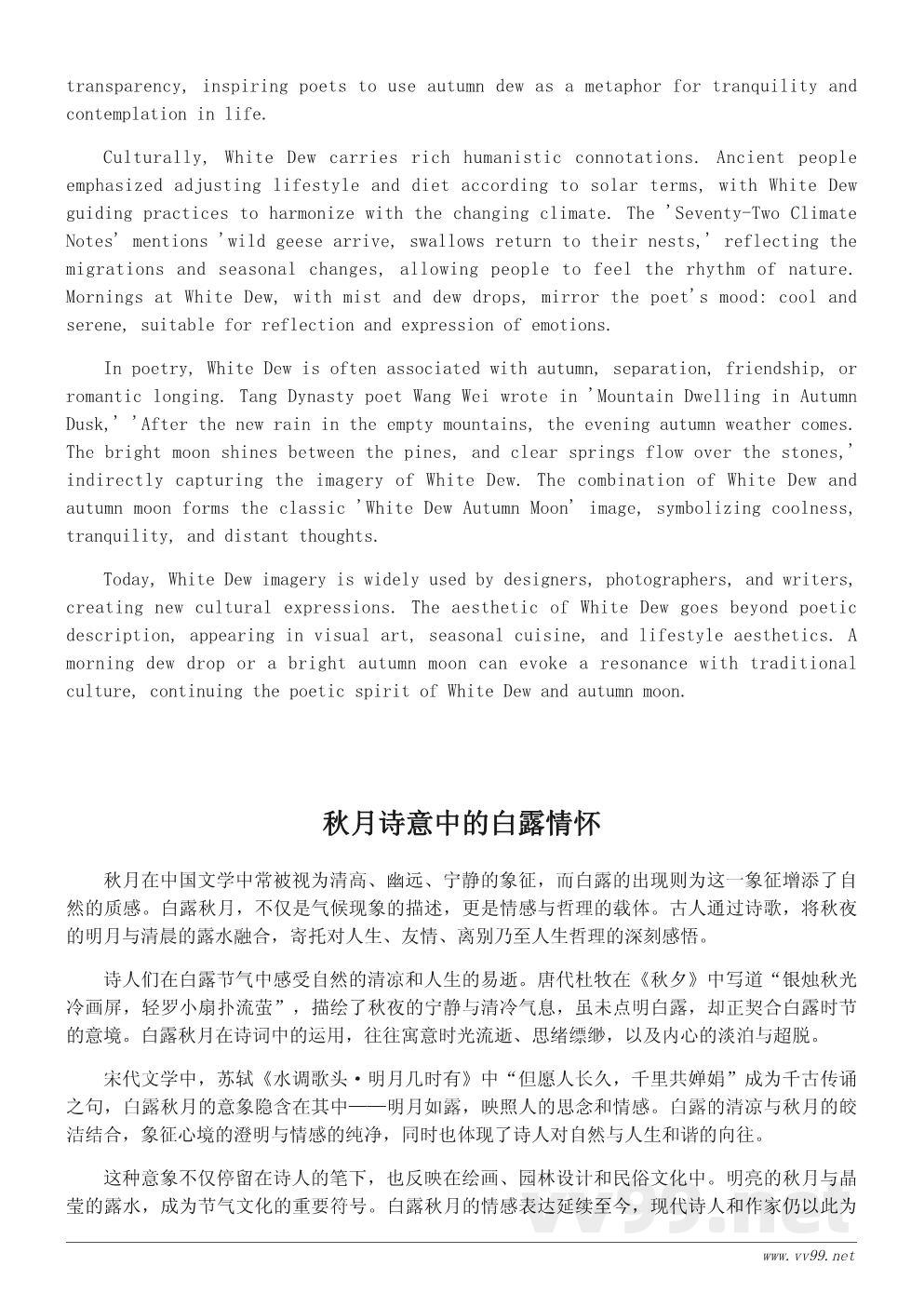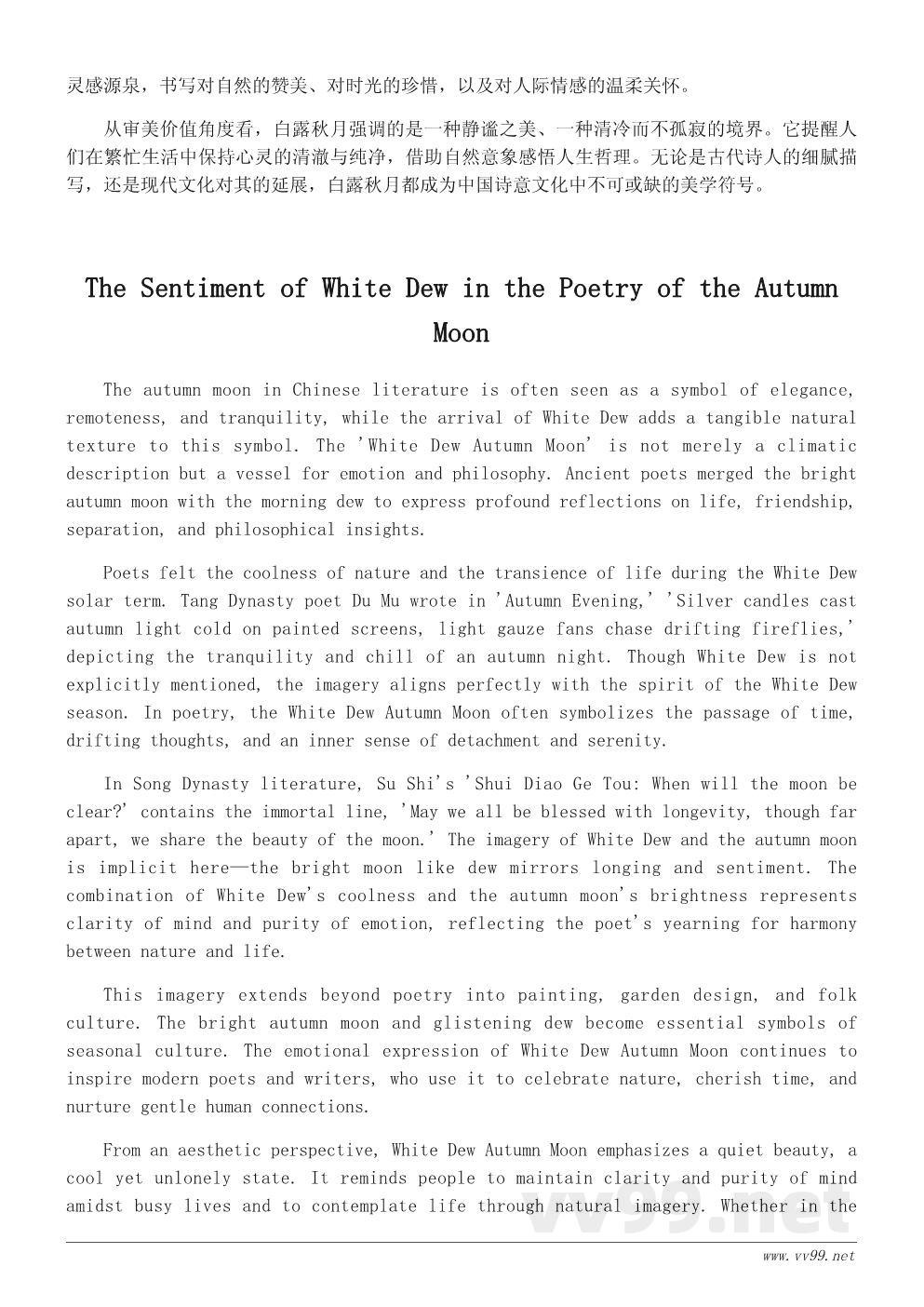白露节气的自然意象与文化内涵
白露,是二十四节气中的第十五个节气,位于每年的九月七日或八日左右,意味着天气由热转凉,秋意渐浓。白露的名称源自自然现象——清晨的草叶上凝结的露珠,晶莹剔透,宛如白色的珠链。古人以细腻的观察力,将自然变化融入生活节律中,白露不仅是气候的标志,更承载着丰收的期待与生命的哲理。
在自然特征上,白露时节昼夜温差明显,早晚凉意渐起,昼长夜短,天空澄明,空气清爽。此时节,田野间稻穗沉甸甸,果园果实累累,仿佛自然在低语:收获的季节到了。白露亦是观察天地之美的时刻,露珠的凝结象征着清净与透明,也启发诗人以秋露比喻人生的淡泊与思索。
文化上,白露承载了丰富的人文意象。古人讲究顺应节气养生,白露时节常有饮食与起居的特殊安排,以适应气候变化。《月令七十二候集解》中记载“鸿雁来宾,玄鸟归巢”,意味着自然界的迁徙与季节更替,人们在节气中感受到天地的律动。白露的清晨,薄雾弥漫,白露点点,正是诗人心境的折射:清凉而静谧,适合感悟人生、抒发情怀。
在诗词中,白露常与秋意、离愁、友情或爱情的离别联系在一起。唐代诗人王维在《山居秋暝》中写道“空山新雨后,天气晚来秋。明月松间照,清泉石上流”,虽未直接点名白露,却以秋月、清露、晚秋景象交织出白露的意境。白露与秋月结合,形成了“白露秋月”的经典形象,象征清冷、宁静以及思绪的悠远。
当代,白露意象被设计师、摄影师、文学创作者广泛采用,形成新的文化表达方式。白露节气的审美不再仅限于诗词描写,更体现在视觉艺术、节气美食和生活美学中。清晨的一滴露水、一轮皎洁的秋月,都能唤起现代人对传统文化的共鸣,延续白露秋月的诗意精神。
Natural Imagery and Cultural Connotation of the White Dew Solar Term
White Dew is the fifteenth solar term in the traditional Chinese calendar, occurring around September 7th or 8th each year, marking the transition from hot to cool weather and the deepening of autumn. The name 'White Dew' comes from the natural phenomenon of dew forming on grass in the morning, glistening like tiny white beads. Ancient Chinese people, with their keen observation, incorporated these natural changes into daily life, making White Dew not only a climatic marker but also a symbol of harvest anticipation and philosophical reflection on life.
In terms of natural characteristics, White Dew brings noticeable temperature differences between day and night, cool mornings and evenings, shorter days, and clear, refreshing skies. Fields are heavy with ripening grains, orchards laden with fruit, as if nature whispers: the harvest season has arrived. White Dew is also a moment to observe the beauty of the world; dew drops symbolize purity and transparency, inspiring poets to use autumn dew as a metaphor for tranquility and contemplation in life.
Culturally, White Dew carries rich humanistic connotations. Ancient people emphasized adjusting lifestyle and diet according to solar terms, with White Dew guiding practices to harmonize with the changing climate. The 'Seventy-Two Climate Notes' mentions 'wild geese arrive, swallows return to their nests,' reflecting the migrations and seasonal changes, allowing people to feel the rhythm of nature. Mornings at White Dew, with mist and dew drops, mirror the poet's mood: cool and serene, suitable for reflection and expression of emotions.
In poetry, White Dew is often associated with autumn, separation, friendship, or romantic longing. Tang Dynasty poet Wang Wei wrote in 'Mountain Dwelling in Autumn Dusk,' 'After the new rain in the empty mountains, the evening autumn weather comes. The bright moon shines between the pines, and clear springs flow over the stones,' indirectly capturing the imagery of White Dew. The combination of White Dew and autumn moon forms the classic 'White Dew Autumn Moon' image, symbolizing coolness, tranquility, and distant thoughts.
Today, White Dew imagery is widely used by designers, photographers, and writers, creating new cultural expressions. The aesthetic of White Dew goes beyond poetic description, appearing in visual art, seasonal cuisine, and lifestyle aesthetics. A morning dew drop or a bright autumn moon can evoke a resonance with traditional culture, continuing the poetic spirit of White Dew and autumn moon.
秋月诗意中的白露情怀
秋月在中国文学中常被视为清高、幽远、宁静的象征,而白露的出现则为这一象征增添了自然的质感。白露秋月,不仅是气候现象的描述,更是情感与哲理的载体。古人通过诗歌,将秋夜的明月与清晨的露水融合,寄托对人生、友情、离别乃至人生哲理的深刻感悟。
诗人们在白露节气中感受自然的清凉和人生的易逝。唐代杜牧在《秋夕》中写道“银烛秋光冷画屏,轻罗小扇扑流萤”,描绘了秋夜的宁静与清冷气息,虽未点明白露,却正契合白露时节的意境。白露秋月在诗词中的运用,往往寓意时光流逝、思绪缥缈,以及内心的淡泊与超脱。
宋代文学中,苏轼《水调歌头·明月几时有》中“但愿人长久,千里共婵娟”成为千古传诵之句,白露秋月的意象隐含在其中——明月如露,映照人的思念和情感。白露的清凉与秋月的皎洁结合,象征心境的澄明与情感的纯净,同时也体现了诗人对自然与人生和谐的向往。
这种意象不仅停留在诗人的笔下,也反映在绘画、园林设计和民俗文化中。明亮的秋月与晶莹的露水,成为节气文化的重要符号。白露秋月的情感表达延续至今,现代诗人和作家仍以此为灵感源泉,书写对自然的赞美、对时光的珍惜,以及对人际情感的温柔关怀。
从审美价值角度看,白露秋月强调的是一种静谧之美、一种清冷而不孤寂的境界。它提醒人们在繁忙生活中保持心灵的清澈与纯净,借助自然意象感悟人生哲理。无论是古代诗人的细腻描写,还是现代文化对其的延展,白露秋月都成为中国诗意文化中不可或缺的美学符号。
The Sentiment of White Dew in the Poetry of the Autumn Moon
The autumn moon in Chinese literature is often seen as a symbol of elegance, remoteness, and tranquility, while the arrival of White Dew adds a tangible natural texture to this symbol. The 'White Dew Autumn Moon' is not merely a climatic description but a vessel for emotion and philosophy. Ancient poets merged the bright autumn moon with the morning dew to express profound reflections on life, friendship, separation, and philosophical insights.
Poets felt the coolness of nature and the transience of life during the White Dew solar term. Tang Dynasty poet Du Mu wrote in 'Autumn Evening,' 'Silver candles cast autumn light cold on painted screens, light gauze fans chase drifting fireflies,' depicting the tranquility and chill of an autumn night. Though White Dew is not explicitly mentioned, the imagery aligns perfectly with the spirit of the White Dew season. In poetry, the White Dew Autumn Moon often symbolizes the passage of time, drifting thoughts, and an inner sense of detachment and serenity.
In Song Dynasty literature, Su Shi's 'Shui Diao Ge Tou: When will the moon be clear?' contains the immortal line, 'May we all be blessed with longevity, though far apart, we share the beauty of the moon.' The imagery of White Dew and the autumn moon is implicit here—the bright moon like dew mirrors longing and sentiment. The combination of White Dew's coolness and the autumn moon's brightness represents clarity of mind and purity of emotion, reflecting the poet's yearning for harmony between nature and life.
This imagery extends beyond poetry into painting, garden design, and folk culture. The bright autumn moon and glistening dew become essential symbols of seasonal culture. The emotional expression of White Dew Autumn Moon continues to inspire modern poets and writers, who use it to celebrate nature, cherish time, and nurture gentle human connections.
From an aesthetic perspective, White Dew Autumn Moon emphasizes a quiet beauty, a cool yet unlonely state. It reminds people to maintain clarity and purity of mind amidst busy lives and to contemplate life through natural imagery. Whether in the delicate depictions of ancient poets or in contemporary cultural expressions, the White Dew Autumn Moon remains an indispensable aesthetic symbol in Chinese poetic culture.
小提示:上面此文档内容仅展示完整文档里的部分内容, 若需要下载完整文档请 点击免费下载完整文档 。





